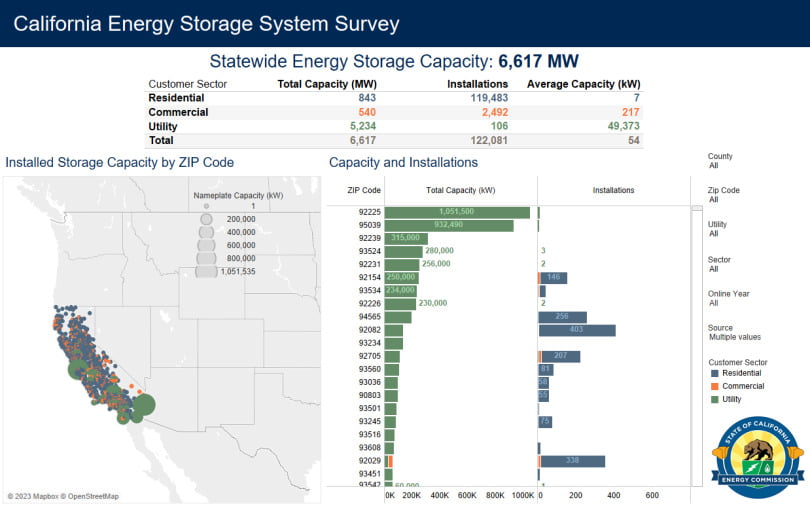But a closer look shows the CEC’s figures may differ slightly to those issued by grid operator CAISO.
The CEC said the 6,617MW breaks down as 5,234MW in the utility-scale sector, 540MW in the commercial and industrial (C&I) sector and 843MW in the residential sector.
However in June CAISO said the quantity of grid-scale alone was 5.6GW as of the start of that month, while CEC’s figures are as of the end of July.
The CEC did break down its figures in an interactive dashboard, an infographic of which is shown below, which breaks down installations by segment, number of installations and zip code. The interactive dashboard is viewable here, although is best viewed using data visualisation platform Tableau.

“Energy storage systems are a great example of how we can harness emerging technology to help create the equitable, reliable and affordable energy grid of the future,” said CEC Vice Chair Siva Gunda.
“California is a global leader in establishing climate policy, but more importantly, it is leading the pack when it comes to putting policy into action and rapidly building projects that add clean, zero-carbon capacity to the grid.”
Most grid-scale BESS projects in the state have 4-hour durations in order to qualify for the full payment under Resource Adequacy, CAISO’s framework through which most BESS are paid by utilities for capacity under long-term agreements.
Gore Street secures US$60 million financing for first California BESS
In related news, UK-based investment fund Gore Street Energy Storage Fund plc (GSF) has secured a US$60 million loan to fund the remaining construction of its 200MW/400MWh BESS project in California.
The Big Rock project, acquired in February 2023, has so far been funded using GSF equity but the loan, from First Citizens Bank, will see it through to its completion and operation in the second half of 2024.
LS Energy Solutions will be providing the BESS technology for the project, its largest to-date, using its AiON-ESS solution.
The loan is for an initial 3-year term and is expected to be refinanced with longer-term project finance once Big Rock becomes operational.
Although the project’s nameplate duration is 2-hours, it will submit a lower power capacity with a 4-hour duration into Resource Adequacy to qualify.

